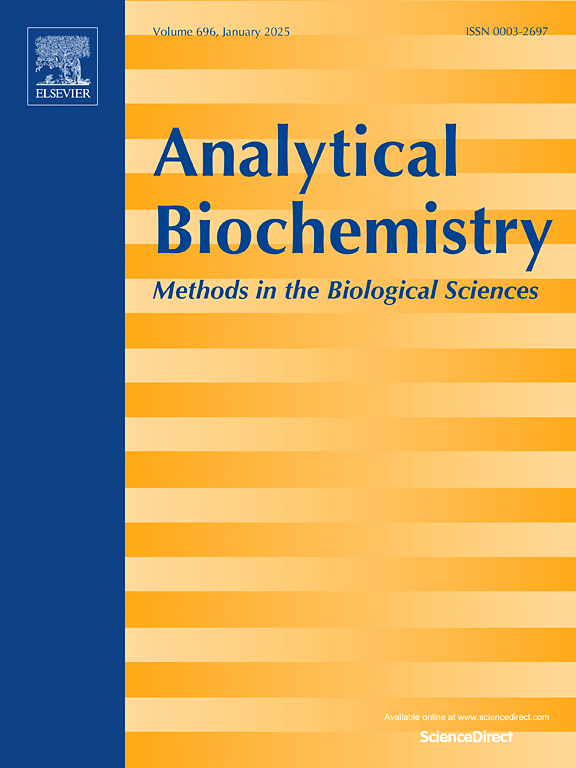Development and validation of a sensitive and fast bioanalytical LC-MS/MS assay for the quantitation of venetoclax and azacitidine in Rat Plasma: Application to pharmacokinetic study
IF 2.5
4区 生物学
Q2 BIOCHEMICAL RESEARCH METHODS
引用次数: 0
Abstract
The combination of venetoclax plus azacitidine (VTX-AZA) is FDA-approved to treat patients with acute myeloid leukemia (AML) aged ≥75 years and has become the standard of care for AML patients. However, the literature has not reported an analytical method for determining VTX-AZA in plasma samples. Therefore, developing an accurate and sensitive bioanalytical assay to quantify VTX-AZA in plasma is important. For the first time, this study describes the development of a new liquid chromatography-tandem mass spectrometry method (LC-MS/MS) for the simultaneous determination of VTX and AZC in plasma samples with its application to pharmacokinetic study in rats. The assay employs repaglinide (RPG) as an internal standard. The chromatographic separations of VTX, AZC, and RPG are achieved within 2.5 min at 25 °C on an Eclipse plus C18 column (100 mm × 2.1 mm, 1.8 μm) and an isocratic mobile phase consisted of water with 0.1 % formic acid and acetonitrile (50:50, v/v, pH 3.2) at a flow rate of 0.30 mL/min. VTX and AZC have been extracted from rat plasma using the solid-phase extraction (SPE) procedure without interference from plasma endogenous. The FDA guidelines were followed in the validation of the developed assay, and linearity in rat plasma was observed for AZC and VTX, respectively, ranging from 5 to 3000 and 5–1000 ng/mL, with r ≥ 0.998. The lower limits of detection (LLOD) were 2 ng/mL for both drugs. In addition, the inter-day and intra-day accuracy were 0.8–6.6 % and 2.2–5.7 %; the inter-day and intra-day precision were 3–6.6 % and 1.5–7.1 %, respectively. The validated assay was effectively used in a pharmacokinetic investigation including the simultaneous oral administration of 40 mg/kg of AZA and 100 mg/kg of VTX to rats. The maximum plasma concentration (Cmax) for AZC and VTX was 794 ± 99.6 ng/mL and 641 ± 96.9 ng/mL achieved at 0.5 ± 0.03 h and 6 ± 0.05 h, respectively. The AUC0-∞ for AZC and VTX was 1253 ± 252.6 and 4881 ± 745.4 ng/mL.h; respectively.

快速高效液相色谱-质谱联用法测定大鼠血浆中维内托松和阿扎胞苷的含量及其药代动力学研究
venetoclax联合阿扎胞苷(VTX-AZA)已获fda批准用于治疗≥75岁的急性髓性白血病(AML)患者,并已成为AML患者的标准治疗方案。然而,文献尚未报道测定血浆样品中VTX-AZA的分析方法。因此,开发一种准确、灵敏的生物分析方法来定量血浆中VTX-AZA是很重要的。本文首次建立了液相色谱-串联质谱(LC-MS/MS)同时测定血浆样品中VTX和AZC的新方法,并将其应用于大鼠体内的药代动力学研究。该试验采用瑞格列奈(RPG)作为内标。采用Eclipse + C18色谱柱(100 mm × 2.1 mm, 1.8 μm),流速为0.30 mL/min,流速为0.1%甲酸和乙腈(50:50,v/v, pH 3.2),在25°C条件下,在2.5 min内实现了VTX、AZC和RPG的色谱分离。采用固相萃取法(SPE)从大鼠血浆中提取了VTX和AZC。该方法的验证遵循FDA指南,AZC和VTX在大鼠血浆中分别呈线性,范围为5-3000和5-1000 ng/mL, r≥0.998。两种药物的检测下限(LLOD)均为2 ng/mL。日间和日内准确率分别为0.8 ~ 6.6%和2.2 ~ 5.7%;日间和日间精度分别为3-6.6%和1.5-7.1%。该方法可用于大鼠同时口服40 mg/kg AZA和100 mg/kg VTX的药代动力学研究。AZC和VTX在0.5±0.03 hr和6±0.05 hr时的最大血药浓度分别为794±99.6 ng/mL和641±96.9 ng/mL。AZC和VTX的AUC0-∞分别为1253±252.6和4881±745.4 ng/mL.h;分别。
本文章由计算机程序翻译,如有差异,请以英文原文为准。
求助全文
约1分钟内获得全文
求助全文
来源期刊

Analytical biochemistry
生物-分析化学
CiteScore
5.70
自引率
0.00%
发文量
283
审稿时长
44 days
期刊介绍:
The journal''s title Analytical Biochemistry: Methods in the Biological Sciences declares its broad scope: methods for the basic biological sciences that include biochemistry, molecular genetics, cell biology, proteomics, immunology, bioinformatics and wherever the frontiers of research take the field.
The emphasis is on methods from the strictly analytical to the more preparative that would include novel approaches to protein purification as well as improvements in cell and organ culture. The actual techniques are equally inclusive ranging from aptamers to zymology.
The journal has been particularly active in:
-Analytical techniques for biological molecules-
Aptamer selection and utilization-
Biosensors-
Chromatography-
Cloning, sequencing and mutagenesis-
Electrochemical methods-
Electrophoresis-
Enzyme characterization methods-
Immunological approaches-
Mass spectrometry of proteins and nucleic acids-
Metabolomics-
Nano level techniques-
Optical spectroscopy in all its forms.
The journal is reluctant to include most drug and strictly clinical studies as there are more suitable publication platforms for these types of papers.
 求助内容:
求助内容: 应助结果提醒方式:
应助结果提醒方式:


